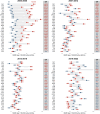Health system financing fragmentation and maternal mortality transition in Mexico, 2000-2022
- PMID: 39881314
- PMCID: PMC11781072
- DOI: 10.1186/s12939-024-02357-3
Health system financing fragmentation and maternal mortality transition in Mexico, 2000-2022
Abstract
Objective: To analyze the temporal and territorial relationship between health system financing fragmentation and maternal mortality in the last two decades in Mexico.
Methods: We conducted an ecological-longitudinal study of the maternal mortality ratio (MMR) in the 32 states of Mexico during the period 2000-2022. Annual MMRs were estimated at the national and state levels according to health insurance. We compared the distribution of individual attributes and place of residence between deceased women with and without social security to identify overrepresented demographic profiles. Finally, we mapped state disparities in MMR by health insurance for the last four political administrations.
Findings: MMR in Mexico decreased from 59.3 maternal deaths per hundred thousand live births in 2000 to 47.3 in 2018. However, from 2019 onwards, MMR increased from 48.7 in 2019 to 72.4 in 2022. Seven out of ten maternal deaths occurred in the population without social security from 2000 to 2018, then decreasing to six out of ten from 2020. Maternal deaths in the population without social security were more frequent among younger women, with less schooling, unmarried, and residing in rural areas, with higher Indigenous presence and greater social marginalization. From 2019 onwards, the MMR was higher in the population with social security.
Conclusion: The results of this study confirm the close relationship between maternal mortality and social inequalities, and suggest that affiliation with social security has ceased to be a differentiating factor in recent years. Understanding the evolution of maternal mortality between the population with and without social security in Mexico allows us to quantify the gap in maternal deaths attributed to inequalities in access to maternal health services, which can contribute to the design of policies that mitigate these gaps.
Keywords: Financing fragmentation; Maternal mortality; Mexico; Universal health coverage.
© 2024. The Author(s).
Conflict of interest statement
Declarations. Ethics approval and consent to participate: Not applicable. This study involved no human participants and was approved by the Research, Ethics, and Biosecurity Committees of the National Institute of Public Health of Mexico (ID:2358/1826/S21-2022). Consent for publication: Not applicable. Competing interests: The authors declare no competing interests.
Figures




Similar articles
-
Maintaining rigor in research: flaws in a recent study and a reanalysis of the relationship between state abortion laws and maternal mortality in Mexico.Contraception. 2017 Jan;95(1):105-111. doi: 10.1016/j.contraception.2016.08.004. Epub 2016 Aug 18. Contraception. 2017. Retraction in: Contraception. 2019 Jan;99(1):71. doi: 10.1016/j.contraception.2018.11.017. PMID: 27546094 Retracted.
-
[Coverage for birth care in Mexico and its interpretation within the context of maternal mortality].Salud Publica Mex. 2013;55 Suppl 2:S214-24. Salud Publica Mex. 2013. PMID: 24626698 Spanish.
-
Tackling maternal mortality by improving technical efficiency in the production of primary health services: longitudinal evidence from the Mexican case.Health Care Manag Sci. 2020 Dec;23(4):571-584. doi: 10.1007/s10729-020-09503-7. Epub 2020 Jul 27. Health Care Manag Sci. 2020. PMID: 32720200
-
The 2023 Latin America report of the Lancet Countdown on health and climate change: the imperative for health-centred climate-resilient development.Lancet Reg Health Am. 2024 Apr 23;33:100746. doi: 10.1016/j.lana.2024.100746. eCollection 2024 May. Lancet Reg Health Am. 2024. PMID: 38800647 Free PMC article. Review.
-
Mexico: Health System Review.Health Syst Transit. 2020 Apr;22(2):1-222. Health Syst Transit. 2020. PMID: 33527902 Review.
References
-
- Bossert T, Blanchet N, Sheetz S, Pinto D, Cali J, Cuevas RP. Comparative review of health system integration in selected countries in Latin America. Washington DC, USA; 2014. Report No.: IDB-TN-585. https://publications.iadb.org/en/publication/11898/comparative-review-he....
-
- Frenk J, Gómez-Dantés O. Health systems in Latin America: the search for universal health coverage. Arch Med Res. 2018;49:79–83. - PubMed
MeSH terms
Grants and funding
LinkOut - more resources
Full Text Sources
Miscellaneous

